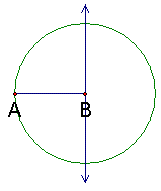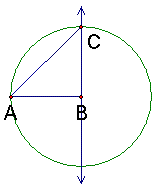Construct the Square Root of 2
The construction of the square root of 2 is based on the Pythagorean Theorem (see Euclid's Postulate 47). Take the premise of the Pythagorean Theorem: A2 + B2 = C2. How can we derive √2?
We can rewrite the equation as C = √(A2 + B2). If we let A = B, we get C = √(A2 + A2) = √(2A2). If we then let A = 1, we get C = √(2(1)2) = √(2). This means that if we construct an Isosceles Right Triangle with the sides A and B of length one (or unity), the length of the hypotenuse will be √2.
| Diagram | Instructions |
|---|---|
 | 1. Let the line segment AB be unity (a line segment of length 1). |
 | 2. Construct a line perpendicular to AB at B. |
 | 3. Construct a circle with center B and radius AB |
 | 4. Mark one intersection of the circle and the perpendicular line C. |
 | 5. Draw line segment CA. The length of line segment CA is √2. |
|
You can change the figure by clicking and dragging on points A and B. Notice that while the measure of the length of AB changes, the ratio of the length of CA to AB is always √2. Proof
|
Citation
Cite this article as:
McAdams, David, Construct the Square Root of 2, from LifeIsAStoryProblem.org, 30 June 2007,
last accessed Sun Apr 06 2025 19:30:25 GMT+0000 (Coordinated Universal Time),
URL https://lifeisastoryproblem.tripod.com/numbers/cons_sqrt_2.html.